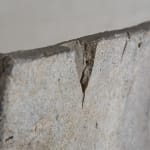



artisan's name unknown
Roof tile of a temple, Mid 13th Century
shirashi ware - pottery
8 1/2” x 12”
Further images
Shirashi Ware was first made in Japan in the late 8th century, in the area between the cities now known as Nagoya and Toyota. Shirashi- Yaki (Shirashi Ware) included both...
Shirashi Ware was first made in Japan in the late 8th century, in the area between the cities now known as Nagoya and Toyota. Shirashi- Yaki (Shirashi Ware) included both glazed and unglazed ware. The kilns died out during the 12th- and 13th- centuries. Facing with this humble roof tile from the Heian era (794 - 1185), one cannot miss the elegant harmony between its contradicting aspects of tremendous force and gracefulness. While a viewer is absorbing and enjoying its characteristics, they realize that the work commands the space around it, causing them to step back a little further to closely interact with the work -- a common physical reaction when encountering a powerful work of art.
Signup for our Newsletter
You will receive two emails a month from us. One introduces artworks and design works from Kyoto's hidden sources and the other is stories from Misako, sharing insights into Japanese culture.
* denotes required fields
为了回应您的查询,我们将根据我们的隐私政策处理您提供的个人数据。



